Report on Soil Improvement by Slurry Injection Under Foundation
VerifiedAdded on 2023/06/13
|9
|1630
|235
Report
AI Summary
This report explores soil improvement techniques, focusing on slurry injection under foundations to enhance bearing capacity and reduce settlement. It discusses the slurry injection technique's advantages, particularly in preserving and rehabilitating structures with positive environmental impacts. The report also examines other soil stabilization methods, including lime, cement, and fly ash stabilization, detailing their processes and effectiveness. Lime stabilization involves adding calcium hydroxide or calcium oxide, while cement stabilization requires careful mixing to ensure uniformity. Fly ash stabilization can improve soil properties, especially when combined with cement or lime. The report concludes that slurry injection is a valuable method for soil improvement, alongside other techniques that offer diverse approaches to enhancing soil stability and durability.
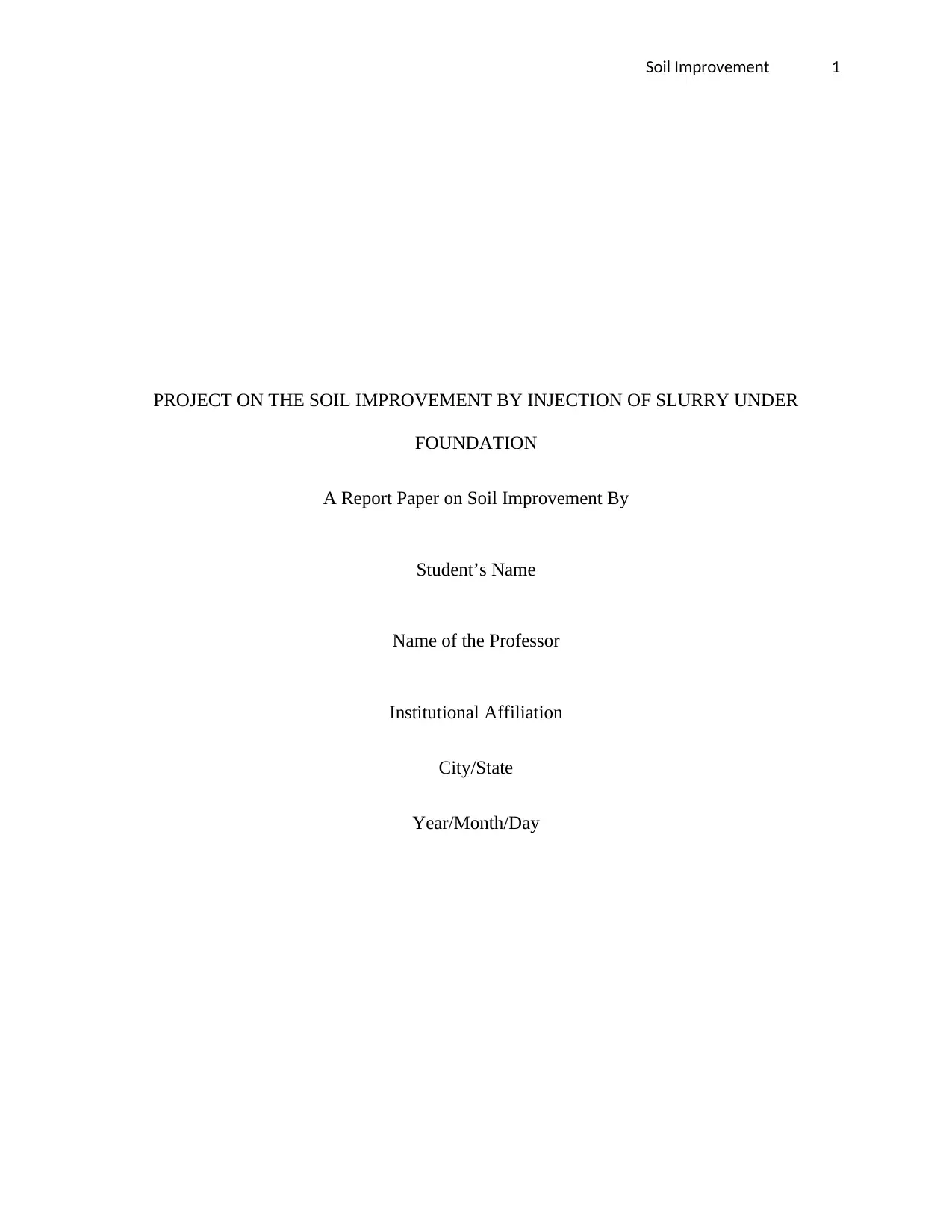
Soil Improvement 1
PROJECT ON THE SOIL IMPROVEMENT BY INJECTION OF SLURRY UNDER
FOUNDATION
A Report Paper on Soil Improvement By
Student’s Name
Name of the Professor
Institutional Affiliation
City/State
Year/Month/Day
PROJECT ON THE SOIL IMPROVEMENT BY INJECTION OF SLURRY UNDER
FOUNDATION
A Report Paper on Soil Improvement By
Student’s Name
Name of the Professor
Institutional Affiliation
City/State
Year/Month/Day
Paraphrase This Document
Need a fresh take? Get an instant paraphrase of this document with our AI Paraphraser
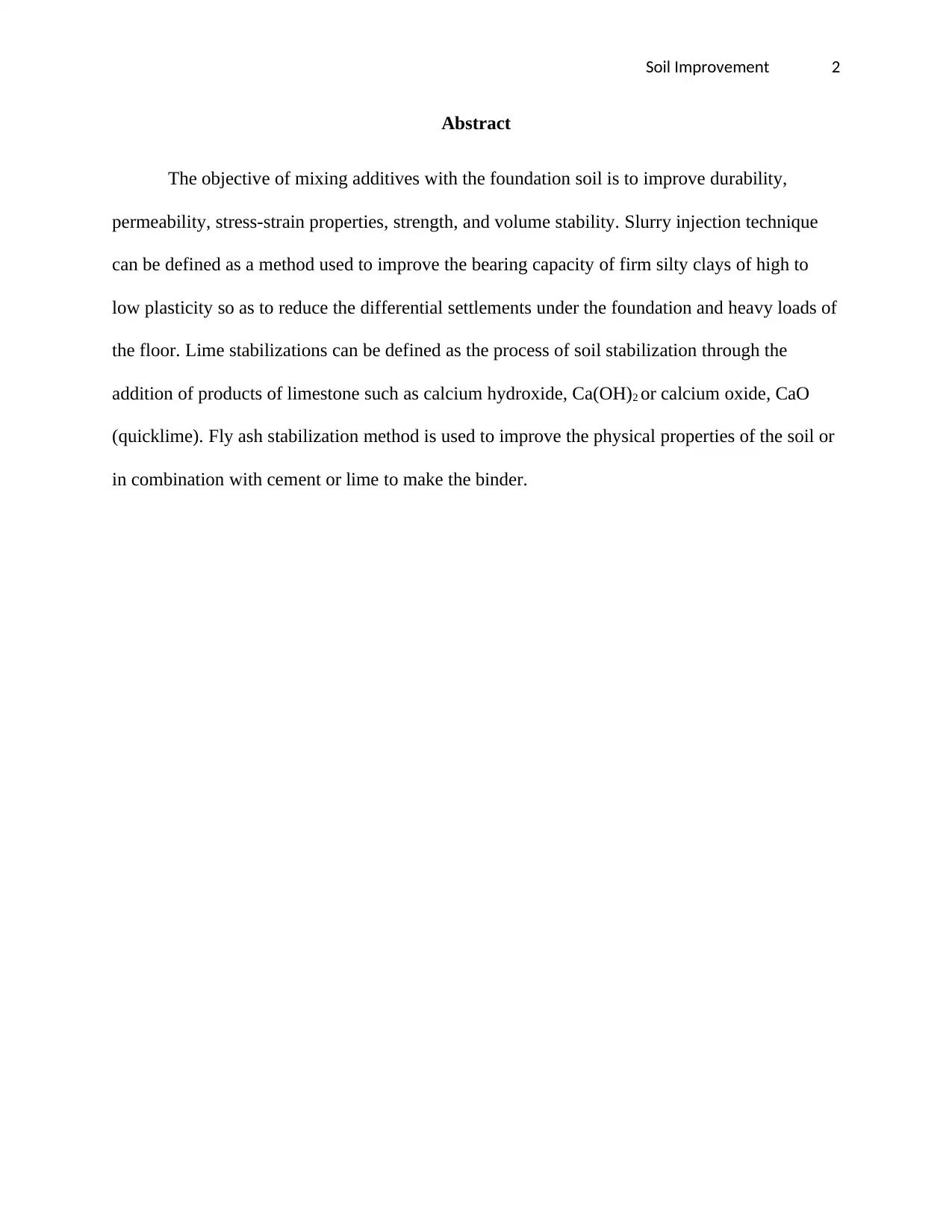
Soil Improvement 2
Abstract
The objective of mixing additives with the foundation soil is to improve durability,
permeability, stress-strain properties, strength, and volume stability. Slurry injection technique
can be defined as a method used to improve the bearing capacity of firm silty clays of high to
low plasticity so as to reduce the differential settlements under the foundation and heavy loads of
the floor. Lime stabilizations can be defined as the process of soil stabilization through the
addition of products of limestone such as calcium hydroxide, Ca(OH)2 or calcium oxide, CaO
(quicklime). Fly ash stabilization method is used to improve the physical properties of the soil or
in combination with cement or lime to make the binder.
Abstract
The objective of mixing additives with the foundation soil is to improve durability,
permeability, stress-strain properties, strength, and volume stability. Slurry injection technique
can be defined as a method used to improve the bearing capacity of firm silty clays of high to
low plasticity so as to reduce the differential settlements under the foundation and heavy loads of
the floor. Lime stabilizations can be defined as the process of soil stabilization through the
addition of products of limestone such as calcium hydroxide, Ca(OH)2 or calcium oxide, CaO
(quicklime). Fly ash stabilization method is used to improve the physical properties of the soil or
in combination with cement or lime to make the binder.
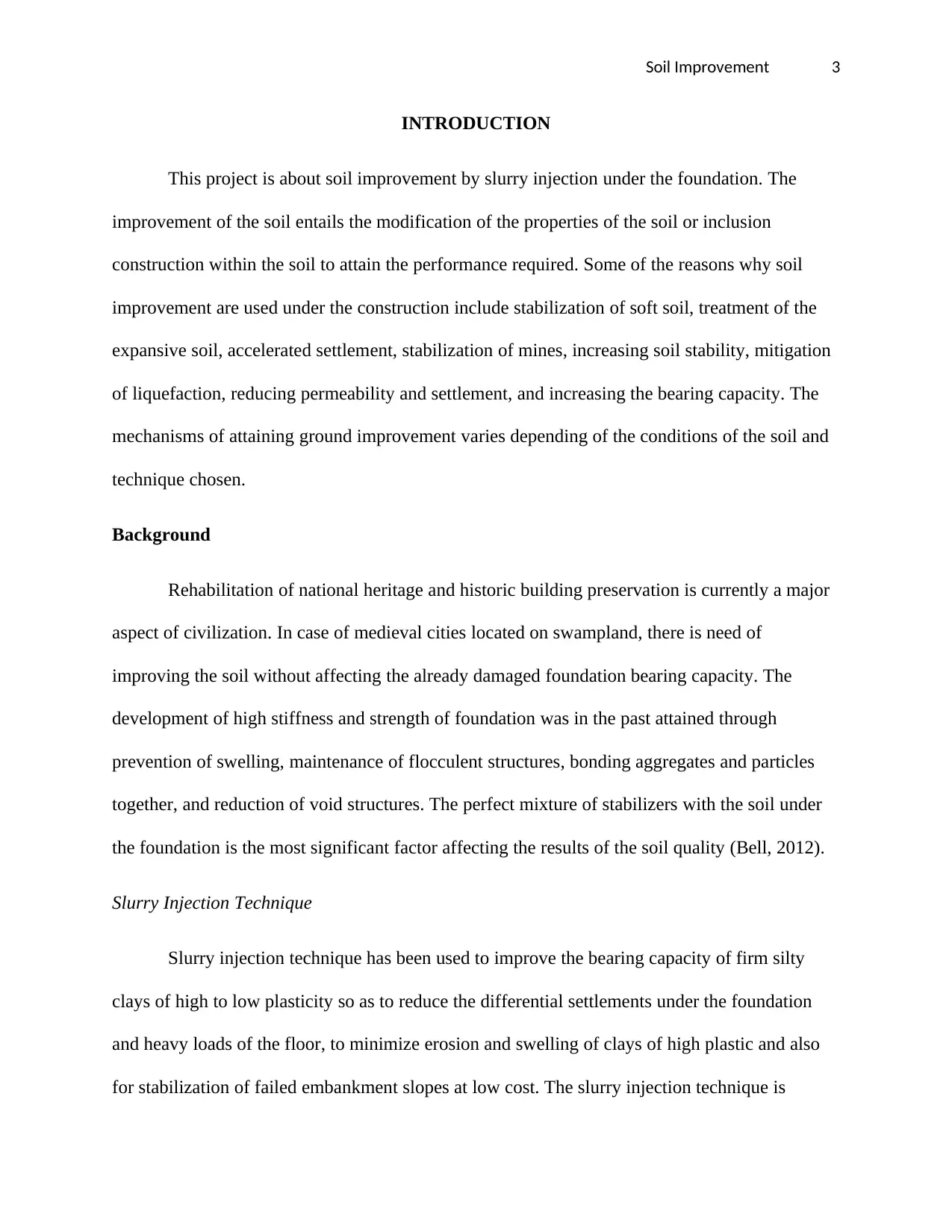
Soil Improvement 3
INTRODUCTION
This project is about soil improvement by slurry injection under the foundation. The
improvement of the soil entails the modification of the properties of the soil or inclusion
construction within the soil to attain the performance required. Some of the reasons why soil
improvement are used under the construction include stabilization of soft soil, treatment of the
expansive soil, accelerated settlement, stabilization of mines, increasing soil stability, mitigation
of liquefaction, reducing permeability and settlement, and increasing the bearing capacity. The
mechanisms of attaining ground improvement varies depending of the conditions of the soil and
technique chosen.
Background
Rehabilitation of national heritage and historic building preservation is currently a major
aspect of civilization. In case of medieval cities located on swampland, there is need of
improving the soil without affecting the already damaged foundation bearing capacity. The
development of high stiffness and strength of foundation was in the past attained through
prevention of swelling, maintenance of flocculent structures, bonding aggregates and particles
together, and reduction of void structures. The perfect mixture of stabilizers with the soil under
the foundation is the most significant factor affecting the results of the soil quality (Bell, 2012).
Slurry Injection Technique
Slurry injection technique has been used to improve the bearing capacity of firm silty
clays of high to low plasticity so as to reduce the differential settlements under the foundation
and heavy loads of the floor, to minimize erosion and swelling of clays of high plastic and also
for stabilization of failed embankment slopes at low cost. The slurry injection technique is
INTRODUCTION
This project is about soil improvement by slurry injection under the foundation. The
improvement of the soil entails the modification of the properties of the soil or inclusion
construction within the soil to attain the performance required. Some of the reasons why soil
improvement are used under the construction include stabilization of soft soil, treatment of the
expansive soil, accelerated settlement, stabilization of mines, increasing soil stability, mitigation
of liquefaction, reducing permeability and settlement, and increasing the bearing capacity. The
mechanisms of attaining ground improvement varies depending of the conditions of the soil and
technique chosen.
Background
Rehabilitation of national heritage and historic building preservation is currently a major
aspect of civilization. In case of medieval cities located on swampland, there is need of
improving the soil without affecting the already damaged foundation bearing capacity. The
development of high stiffness and strength of foundation was in the past attained through
prevention of swelling, maintenance of flocculent structures, bonding aggregates and particles
together, and reduction of void structures. The perfect mixture of stabilizers with the soil under
the foundation is the most significant factor affecting the results of the soil quality (Bell, 2012).
Slurry Injection Technique
Slurry injection technique has been used to improve the bearing capacity of firm silty
clays of high to low plasticity so as to reduce the differential settlements under the foundation
and heavy loads of the floor, to minimize erosion and swelling of clays of high plastic and also
for stabilization of failed embankment slopes at low cost. The slurry injection technique is
⊘ This is a preview!⊘
Do you want full access?
Subscribe today to unlock all pages.

Trusted by 1+ million students worldwide
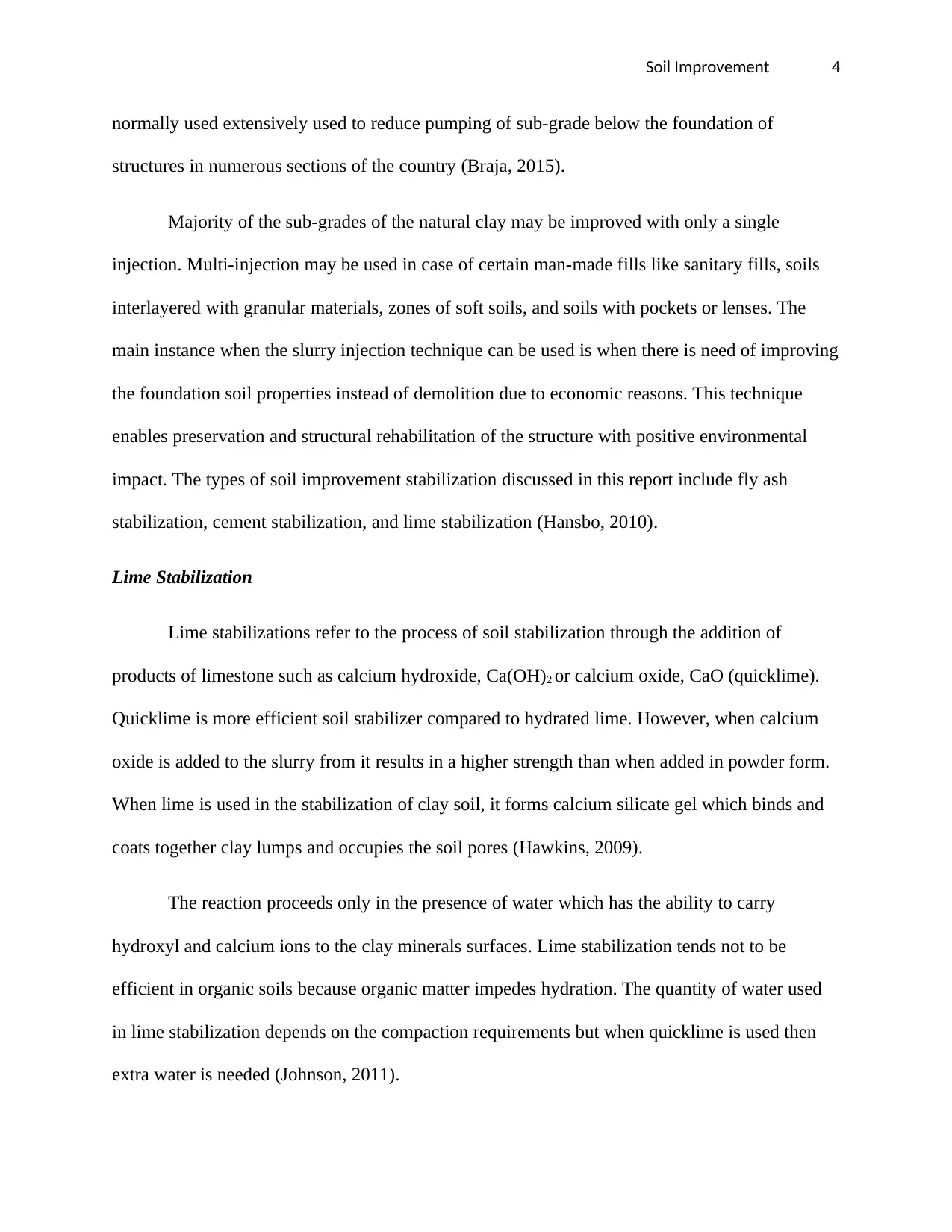
Soil Improvement 4
normally used extensively used to reduce pumping of sub-grade below the foundation of
structures in numerous sections of the country (Braja, 2015).
Majority of the sub-grades of the natural clay may be improved with only a single
injection. Multi-injection may be used in case of certain man-made fills like sanitary fills, soils
interlayered with granular materials, zones of soft soils, and soils with pockets or lenses. The
main instance when the slurry injection technique can be used is when there is need of improving
the foundation soil properties instead of demolition due to economic reasons. This technique
enables preservation and structural rehabilitation of the structure with positive environmental
impact. The types of soil improvement stabilization discussed in this report include fly ash
stabilization, cement stabilization, and lime stabilization (Hansbo, 2010).
Lime Stabilization
Lime stabilizations refer to the process of soil stabilization through the addition of
products of limestone such as calcium hydroxide, Ca(OH)2 or calcium oxide, CaO (quicklime).
Quicklime is more efficient soil stabilizer compared to hydrated lime. However, when calcium
oxide is added to the slurry from it results in a higher strength than when added in powder form.
When lime is used in the stabilization of clay soil, it forms calcium silicate gel which binds and
coats together clay lumps and occupies the soil pores (Hawkins, 2009).
The reaction proceeds only in the presence of water which has the ability to carry
hydroxyl and calcium ions to the clay minerals surfaces. Lime stabilization tends not to be
efficient in organic soils because organic matter impedes hydration. The quantity of water used
in lime stabilization depends on the compaction requirements but when quicklime is used then
extra water is needed (Johnson, 2011).
normally used extensively used to reduce pumping of sub-grade below the foundation of
structures in numerous sections of the country (Braja, 2015).
Majority of the sub-grades of the natural clay may be improved with only a single
injection. Multi-injection may be used in case of certain man-made fills like sanitary fills, soils
interlayered with granular materials, zones of soft soils, and soils with pockets or lenses. The
main instance when the slurry injection technique can be used is when there is need of improving
the foundation soil properties instead of demolition due to economic reasons. This technique
enables preservation and structural rehabilitation of the structure with positive environmental
impact. The types of soil improvement stabilization discussed in this report include fly ash
stabilization, cement stabilization, and lime stabilization (Hansbo, 2010).
Lime Stabilization
Lime stabilizations refer to the process of soil stabilization through the addition of
products of limestone such as calcium hydroxide, Ca(OH)2 or calcium oxide, CaO (quicklime).
Quicklime is more efficient soil stabilizer compared to hydrated lime. However, when calcium
oxide is added to the slurry from it results in a higher strength than when added in powder form.
When lime is used in the stabilization of clay soil, it forms calcium silicate gel which binds and
coats together clay lumps and occupies the soil pores (Hawkins, 2009).
The reaction proceeds only in the presence of water which has the ability to carry
hydroxyl and calcium ions to the clay minerals surfaces. Lime stabilization tends not to be
efficient in organic soils because organic matter impedes hydration. The quantity of water used
in lime stabilization depends on the compaction requirements but when quicklime is used then
extra water is needed (Johnson, 2011).
Paraphrase This Document
Need a fresh take? Get an instant paraphrase of this document with our AI Paraphraser
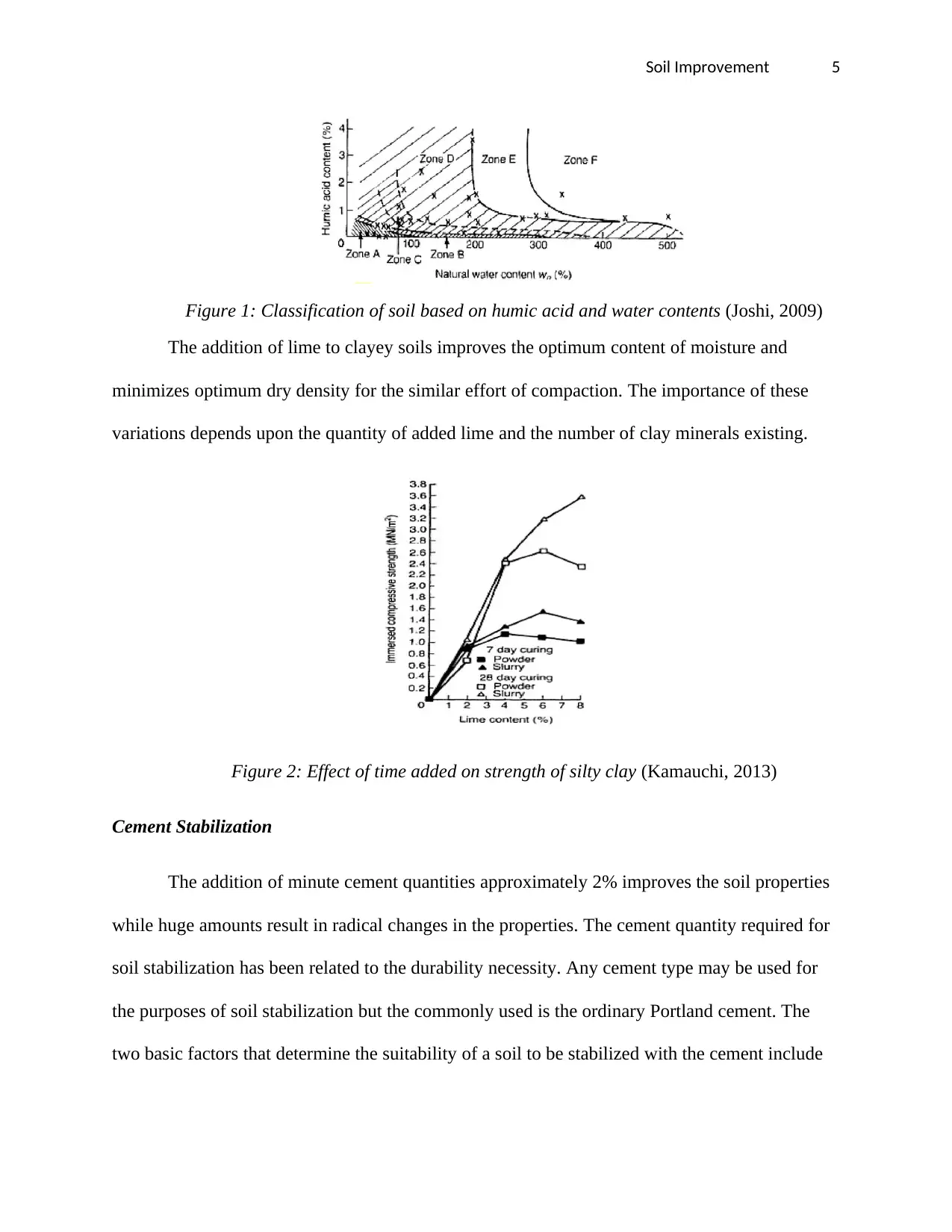
Soil Improvement 5
Figure 1: Classification of soil based on humic acid and water contents (Joshi, 2009)
The addition of lime to clayey soils improves the optimum content of moisture and
minimizes optimum dry density for the similar effort of compaction. The importance of these
variations depends upon the quantity of added lime and the number of clay minerals existing.
Figure 2: Effect of time added on strength of silty clay (Kamauchi, 2013)
Cement Stabilization
The addition of minute cement quantities approximately 2% improves the soil properties
while huge amounts result in radical changes in the properties. The cement quantity required for
soil stabilization has been related to the durability necessity. Any cement type may be used for
the purposes of soil stabilization but the commonly used is the ordinary Portland cement. The
two basic factors that determine the suitability of a soil to be stabilized with the cement include
Figure 1: Classification of soil based on humic acid and water contents (Joshi, 2009)
The addition of lime to clayey soils improves the optimum content of moisture and
minimizes optimum dry density for the similar effort of compaction. The importance of these
variations depends upon the quantity of added lime and the number of clay minerals existing.
Figure 2: Effect of time added on strength of silty clay (Kamauchi, 2013)
Cement Stabilization
The addition of minute cement quantities approximately 2% improves the soil properties
while huge amounts result in radical changes in the properties. The cement quantity required for
soil stabilization has been related to the durability necessity. Any cement type may be used for
the purposes of soil stabilization but the commonly used is the ordinary Portland cement. The
two basic factors that determine the suitability of a soil to be stabilized with the cement include
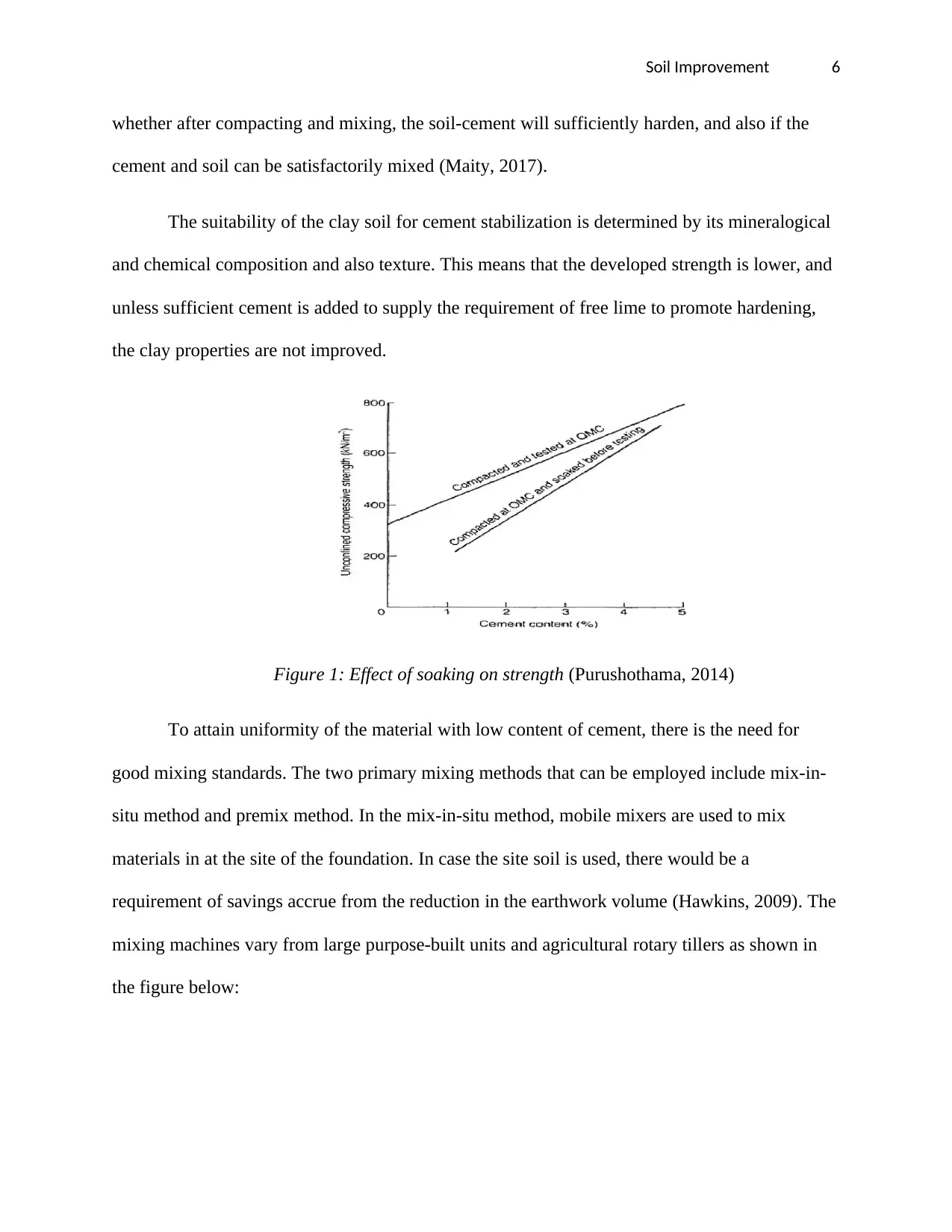
Soil Improvement 6
whether after compacting and mixing, the soil-cement will sufficiently harden, and also if the
cement and soil can be satisfactorily mixed (Maity, 2017).
The suitability of the clay soil for cement stabilization is determined by its mineralogical
and chemical composition and also texture. This means that the developed strength is lower, and
unless sufficient cement is added to supply the requirement of free lime to promote hardening,
the clay properties are not improved.
Figure 1: Effect of soaking on strength (Purushothama, 2014)
To attain uniformity of the material with low content of cement, there is the need for
good mixing standards. The two primary mixing methods that can be employed include mix-in-
situ method and premix method. In the mix-in-situ method, mobile mixers are used to mix
materials in at the site of the foundation. In case the site soil is used, there would be a
requirement of savings accrue from the reduction in the earthwork volume (Hawkins, 2009). The
mixing machines vary from large purpose-built units and agricultural rotary tillers as shown in
the figure below:
whether after compacting and mixing, the soil-cement will sufficiently harden, and also if the
cement and soil can be satisfactorily mixed (Maity, 2017).
The suitability of the clay soil for cement stabilization is determined by its mineralogical
and chemical composition and also texture. This means that the developed strength is lower, and
unless sufficient cement is added to supply the requirement of free lime to promote hardening,
the clay properties are not improved.
Figure 1: Effect of soaking on strength (Purushothama, 2014)
To attain uniformity of the material with low content of cement, there is the need for
good mixing standards. The two primary mixing methods that can be employed include mix-in-
situ method and premix method. In the mix-in-situ method, mobile mixers are used to mix
materials in at the site of the foundation. In case the site soil is used, there would be a
requirement of savings accrue from the reduction in the earthwork volume (Hawkins, 2009). The
mixing machines vary from large purpose-built units and agricultural rotary tillers as shown in
the figure below:
⊘ This is a preview!⊘
Do you want full access?
Subscribe today to unlock all pages.

Trusted by 1+ million students worldwide
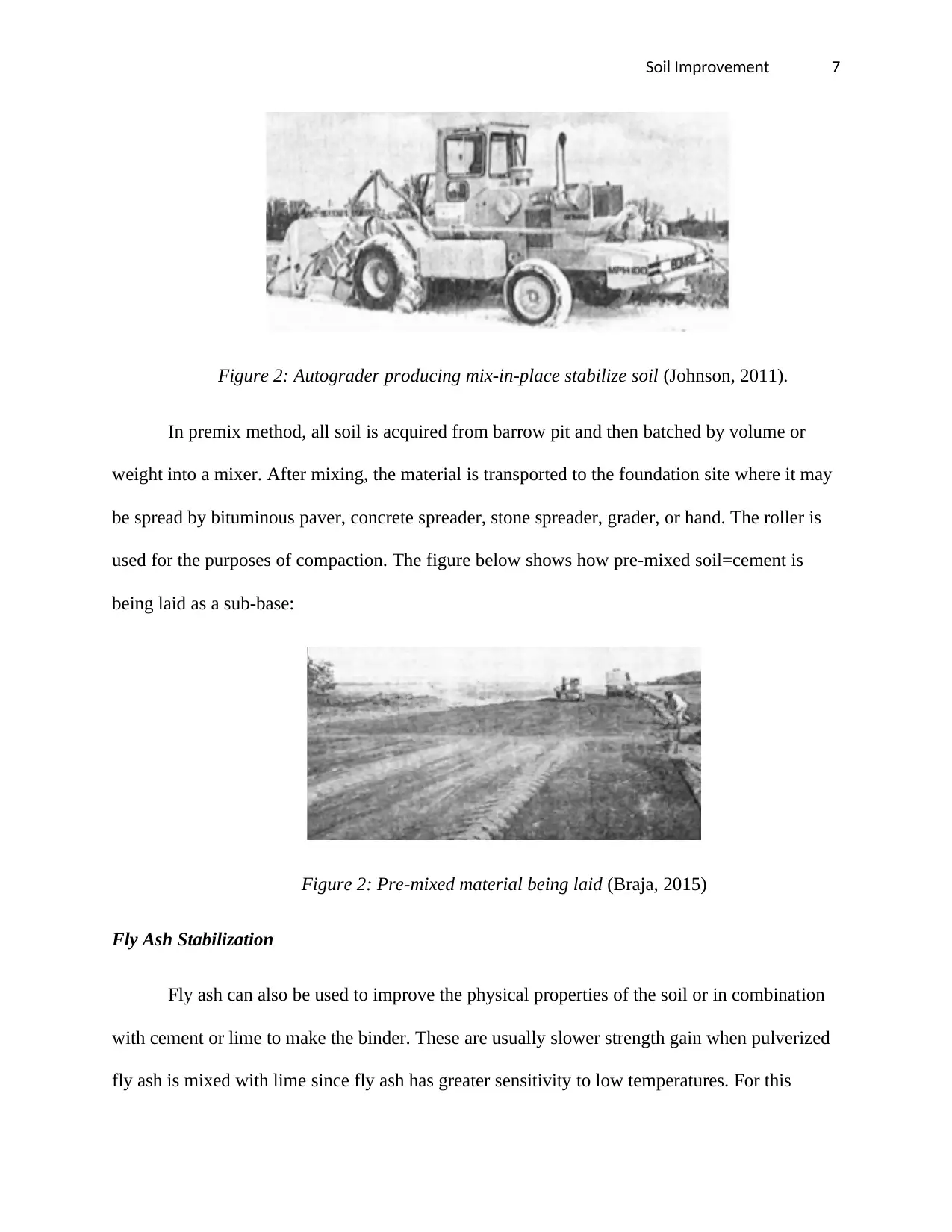
Soil Improvement 7
Figure 2: Autograder producing mix-in-place stabilize soil (Johnson, 2011).
In premix method, all soil is acquired from barrow pit and then batched by volume or
weight into a mixer. After mixing, the material is transported to the foundation site where it may
be spread by bituminous paver, concrete spreader, stone spreader, grader, or hand. The roller is
used for the purposes of compaction. The figure below shows how pre-mixed soil=cement is
being laid as a sub-base:
Figure 2: Pre-mixed material being laid (Braja, 2015)
Fly Ash Stabilization
Fly ash can also be used to improve the physical properties of the soil or in combination
with cement or lime to make the binder. These are usually slower strength gain when pulverized
fly ash is mixed with lime since fly ash has greater sensitivity to low temperatures. For this
Figure 2: Autograder producing mix-in-place stabilize soil (Johnson, 2011).
In premix method, all soil is acquired from barrow pit and then batched by volume or
weight into a mixer. After mixing, the material is transported to the foundation site where it may
be spread by bituminous paver, concrete spreader, stone spreader, grader, or hand. The roller is
used for the purposes of compaction. The figure below shows how pre-mixed soil=cement is
being laid as a sub-base:
Figure 2: Pre-mixed material being laid (Braja, 2015)
Fly Ash Stabilization
Fly ash can also be used to improve the physical properties of the soil or in combination
with cement or lime to make the binder. These are usually slower strength gain when pulverized
fly ash is mixed with lime since fly ash has greater sensitivity to low temperatures. For this
Paraphrase This Document
Need a fresh take? Get an instant paraphrase of this document with our AI Paraphraser
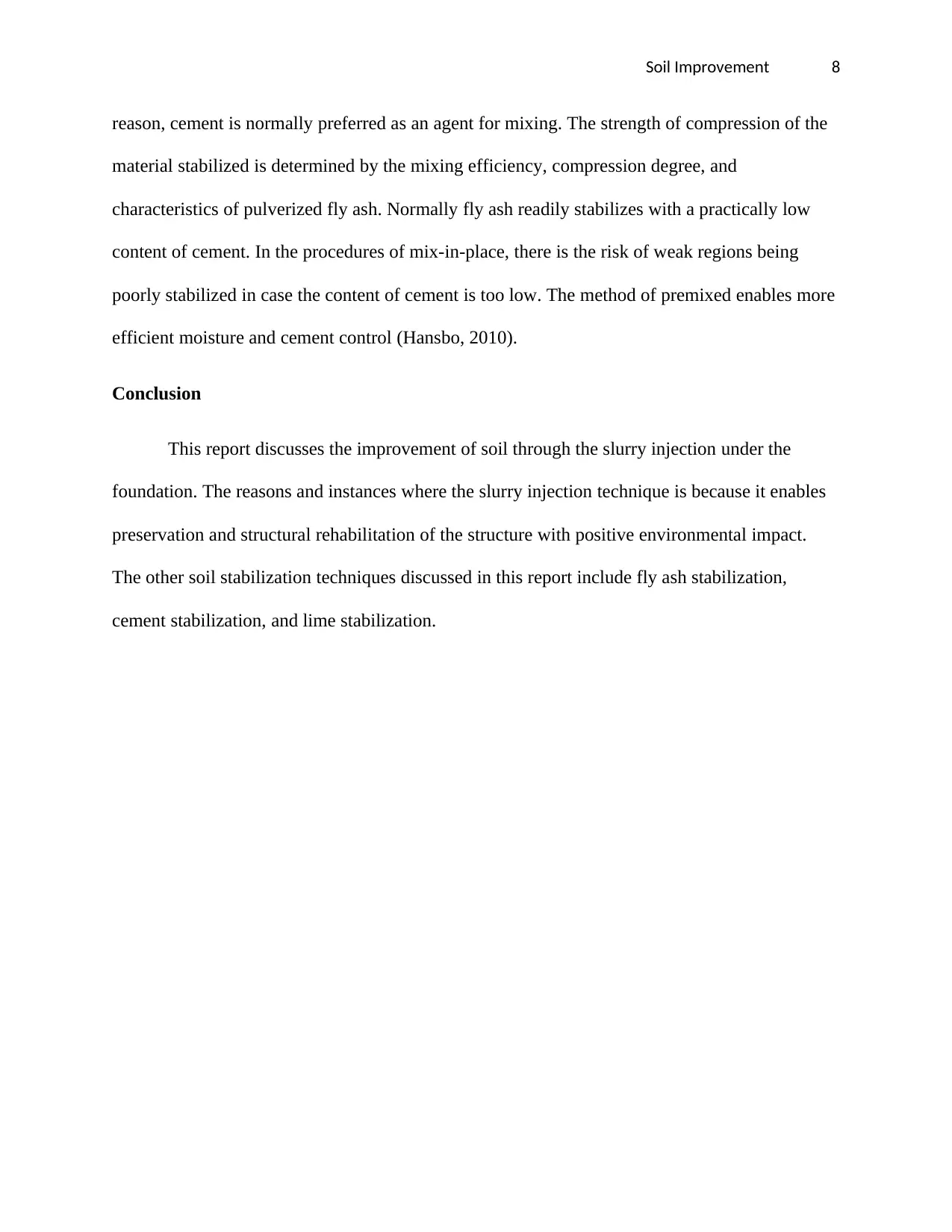
Soil Improvement 8
reason, cement is normally preferred as an agent for mixing. The strength of compression of the
material stabilized is determined by the mixing efficiency, compression degree, and
characteristics of pulverized fly ash. Normally fly ash readily stabilizes with a practically low
content of cement. In the procedures of mix-in-place, there is the risk of weak regions being
poorly stabilized in case the content of cement is too low. The method of premixed enables more
efficient moisture and cement control (Hansbo, 2010).
Conclusion
This report discusses the improvement of soil through the slurry injection under the
foundation. The reasons and instances where the slurry injection technique is because it enables
preservation and structural rehabilitation of the structure with positive environmental impact.
The other soil stabilization techniques discussed in this report include fly ash stabilization,
cement stabilization, and lime stabilization.
reason, cement is normally preferred as an agent for mixing. The strength of compression of the
material stabilized is determined by the mixing efficiency, compression degree, and
characteristics of pulverized fly ash. Normally fly ash readily stabilizes with a practically low
content of cement. In the procedures of mix-in-place, there is the risk of weak regions being
poorly stabilized in case the content of cement is too low. The method of premixed enables more
efficient moisture and cement control (Hansbo, 2010).
Conclusion
This report discusses the improvement of soil through the slurry injection under the
foundation. The reasons and instances where the slurry injection technique is because it enables
preservation and structural rehabilitation of the structure with positive environmental impact.
The other soil stabilization techniques discussed in this report include fly ash stabilization,
cement stabilization, and lime stabilization.
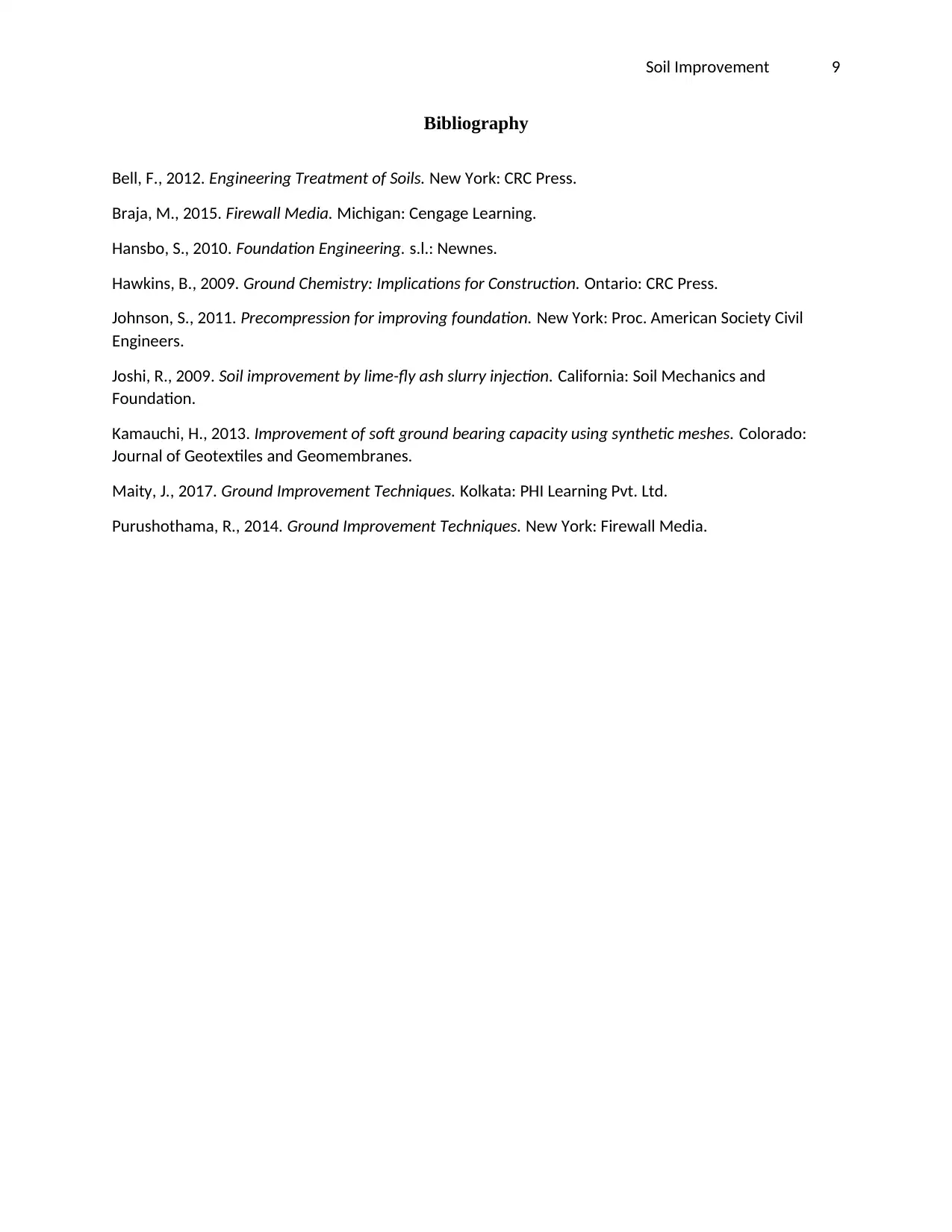
Soil Improvement 9
Bibliography
Bell, F., 2012. Engineering Treatment of Soils. New York: CRC Press.
Braja, M., 2015. Firewall Media. Michigan: Cengage Learning.
Hansbo, S., 2010. Foundation Engineering. s.l.: Newnes.
Hawkins, B., 2009. Ground Chemistry: Implications for Construction. Ontario: CRC Press.
Johnson, S., 2011. Precompression for improving foundation. New York: Proc. American Society Civil
Engineers.
Joshi, R., 2009. Soil improvement by lime-fly ash slurry injection. California: Soil Mechanics and
Foundation.
Kamauchi, H., 2013. Improvement of soft ground bearing capacity using synthetic meshes. Colorado:
Journal of Geotextiles and Geomembranes.
Maity, J., 2017. Ground Improvement Techniques. Kolkata: PHI Learning Pvt. Ltd.
Purushothama, R., 2014. Ground Improvement Techniques. New York: Firewall Media.
Bibliography
Bell, F., 2012. Engineering Treatment of Soils. New York: CRC Press.
Braja, M., 2015. Firewall Media. Michigan: Cengage Learning.
Hansbo, S., 2010. Foundation Engineering. s.l.: Newnes.
Hawkins, B., 2009. Ground Chemistry: Implications for Construction. Ontario: CRC Press.
Johnson, S., 2011. Precompression for improving foundation. New York: Proc. American Society Civil
Engineers.
Joshi, R., 2009. Soil improvement by lime-fly ash slurry injection. California: Soil Mechanics and
Foundation.
Kamauchi, H., 2013. Improvement of soft ground bearing capacity using synthetic meshes. Colorado:
Journal of Geotextiles and Geomembranes.
Maity, J., 2017. Ground Improvement Techniques. Kolkata: PHI Learning Pvt. Ltd.
Purushothama, R., 2014. Ground Improvement Techniques. New York: Firewall Media.
⊘ This is a preview!⊘
Do you want full access?
Subscribe today to unlock all pages.

Trusted by 1+ million students worldwide
1 out of 9
Related Documents
Your All-in-One AI-Powered Toolkit for Academic Success.
+13062052269
info@desklib.com
Available 24*7 on WhatsApp / Email
![[object Object]](/_next/static/media/star-bottom.7253800d.svg)
Unlock your academic potential
Copyright © 2020–2025 A2Z Services. All Rights Reserved. Developed and managed by ZUCOL.





